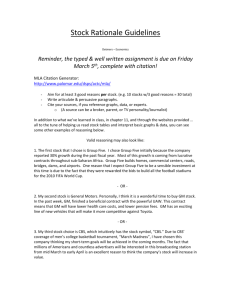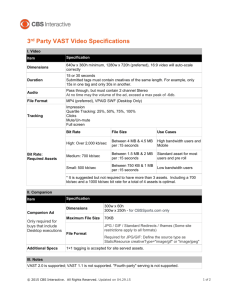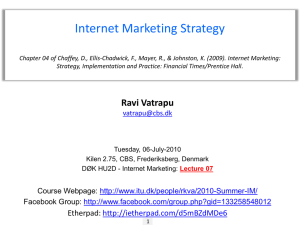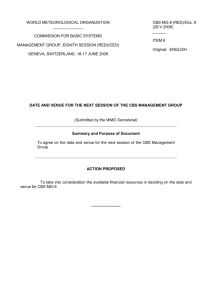60 Minutes - E Natural Health Center
advertisement
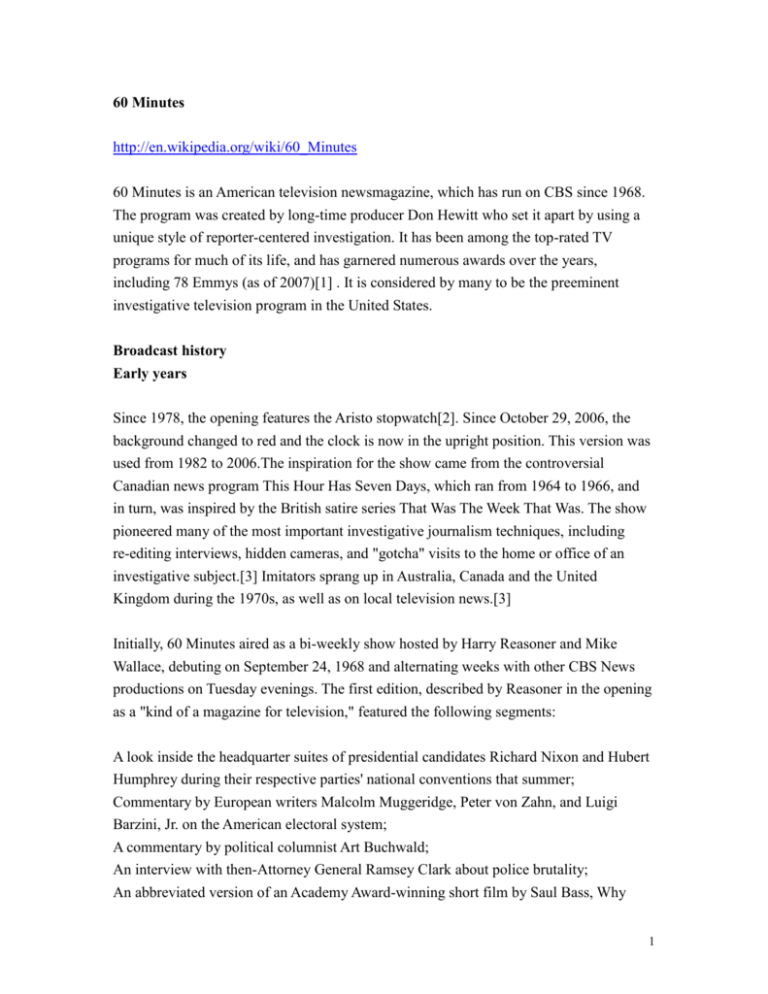
60 Minutes http://en.wikipedia.org/wiki/60_Minutes 60 Minutes is an American television newsmagazine, which has run on CBS since 1968. The program was created by long-time producer Don Hewitt who set it apart by using a unique style of reporter-centered investigation. It has been among the top-rated TV programs for much of its life, and has garnered numerous awards over the years, including 78 Emmys (as of 2007)[1] . It is considered by many to be the preeminent investigative television program in the United States. Broadcast history Early years Since 1978, the opening features the Aristo stopwatch[2]. Since October 29, 2006, the background changed to red and the clock is now in the upright position. This version was used from 1982 to 2006.The inspiration for the show came from the controversial Canadian news program This Hour Has Seven Days, which ran from 1964 to 1966, and in turn, was inspired by the British satire series That Was The Week That Was. The show pioneered many of the most important investigative journalism techniques, including re-editing interviews, hidden cameras, and "gotcha" visits to the home or office of an investigative subject.[3] Imitators sprang up in Australia, Canada and the United Kingdom during the 1970s, as well as on local television news.[3] Initially, 60 Minutes aired as a bi-weekly show hosted by Harry Reasoner and Mike Wallace, debuting on September 24, 1968 and alternating weeks with other CBS News productions on Tuesday evenings. The first edition, described by Reasoner in the opening as a "kind of a magazine for television," featured the following segments: A look inside the headquarter suites of presidential candidates Richard Nixon and Hubert Humphrey during their respective parties' national conventions that summer; Commentary by European writers Malcolm Muggeridge, Peter von Zahn, and Luigi Barzini, Jr. on the American electoral system; A commentary by political columnist Art Buchwald; An interview with then-Attorney General Ramsey Clark about police brutality; An abbreviated version of an Academy Award-winning short film by Saul Bass, Why 1 Man Creates; and A meditation by Wallace and Reasoner on the relation between perception and reality. Wallace said that the show aimed to "reflect reality," while acknowledging the differing perceptions of it. The first "magazine-cover" chroma key was a photo of two helmeted policemen (for the Clark interview segment). Wallace and Reasoner sat in chairs on opposite sides of the set, which had a cream-colored backdrop; the more famous black backdrop (which is still used as of 2009) did not appear until the following year. The logo was in Helvetica type with the word "Minutes" spelled in all lower-case letters; the logo most associated with the show did not appear until about 1974. Further, to extend the magazine motif, the producers added a "Vol. xx, No. xx" to the title display on the chroma key; that was seen until about 1971. The trademark stopwatch, however, did not appear on the inaugural broadcast; it would not debut until several episodes later. Alpo dog food was the sole sponsor of the first program.[4][5] Don Hewitt, who had been a producer of the CBS Evening News with Walter Cronkite, sought out Wallace as a stylistic contrast to Reasoner.[6] According to one historian of the show, the idea of the format was to make the hosts the reporters, to always feature stories that were of national importance but focused upon individuals involved with, or in conflict with, those issues, and to limit the reports' airtime to around thirteen minutes [7]. However, the initial season was troubled by lack of network confidence, as the show did not garner ratings much higher than that of other CBS News documentaries. As a rule, during that era, news programming during prime time lost money; networks mainly scheduled public affairs programs in prime time in order to bolster the prestige of their news departments, and thus boost ratings for the regular evening newscasts, which were seen by far more people than documentaries and the like. 60 Minutes struggled under that stigma during its first three years. Changes to 60 Minutes came fairly early in the program's history. When Reasoner left CBS to co-anchor ABC's evening newscast (he would return to CBS and the show in 1978), Morley Safer joined the team in 1970, and he took over Reasoner's duties of reporting less aggressive stories. However, when Richard Nixon began targeting press access and reporting, even Safer, formerly the CBS News bureau head in Saigon and London, began to do "hard" investigative reports, and during the 1970–71 season alone 2 60 Minutes reported on cluster bombs, the South Vietnamese Army, Canada's amnesty for American draft dodgers, Nigeria, the Middle East, and Northern Ireland.[8] "Point/Counterpoint" segment In 1971, the "Point/Counterpoint" segment was introduced, featuring James J. Kilpatrick and Nicholas von Hoffman (later Shana Alexander), a three-minute debate between spokespeople for the political right and left, respectively. This segment pioneered a format that would later be adapted by CNN for its Crossfire show. This ran until 1979, when Andy Rooney, whose commentaries were already alternating with the debate segment since the fall of 1978, replaced it; Rooney remains with the program today. Effects from the Prime Time Access Rule By 1971, the FCC introduced the Prime Time Access Rule, which freed local network affiliates in the top 50 markets (in practice, the entire network) to take a half hour of prime time from the networks on Mondays through Saturdays and one full hour on Sundays. Because nearly all affiliates found production costs for the FCC's intended goal of increased public affairs programming very high and the ratings (thus advertising revenues) low, making it mostly unprofitable, the FCC created an exception for network-authored news and public affairs. After a six-month hiatus in late 1971, CBS thus found a prime place for 60 Minutes in a portion of that displaced time, 6–7 p.m. (Eastern time; 5–6 Central) on Sundays, in January 1972.[8] This proved somewhat less than satisfactory, however, because in order to accommodate CBS' telecasts of late afternoon National Football League games, 60 Minutes went on hiatus during the fall from 1972 to 1975 (and the summer of 1972). This took place because football telecasts were protected contractually from interruptions in the wake of the infamous "Heidi Game" incident on NBC in November 1968. Despite the irregular scheduling, the program's hard-hitting reports attracted a steadily growing audience, particularly during the waning days of the Vietnam War and the gripping events of the Watergate scandal; at that time, few if any other major-network news shows did in-depth investigative reporting to the degree carried out by 60 Minutes. Eventually, during the summers of 1973 through 1975, CBS did allow the show back onto the prime time schedule proper, on Fridays in 1973 and Sundays the two years thereafter, as a replacement for the regular season's program. It was only when the FCC returned an hour to the networks on Sundays (for 3 children's/family or news programming), taken away from them four years earlier, in a 1975 amendment to the Access Rule that CBS finally found a viable permanent timeslot for 60 Minutes. When a family-oriented drama, Three for the Road, ended after a 13-week run in the fall, the newsmagazine took its place at 7/6 p.m. on December 7. It has aired at that time since, for over 33 years, making 60 Minutes not only the longest-running prime time program currently in production, but also the television program (excluding daily programs such as evening newscasts or breakfast shows) broadcasting for the longest length of time at a single time period each week in U.S. television history. This move, and the addition of then-White House correspondent Dan Rather to the reporting team, made the program into a strong ratings hit and, eventually, a general cultural phenomenon. This was no less than a stunning reversal of the previously poor ratings performances of documentary programs on network television, as mentioned above. By 1976, 60 Minutes became the top-rated show on Sunday nights in the U.S. By 1979, it had achieved the number-one Nielsen rating for all television programs, unheard of before for a news broadcast in prime time. This success translated into great profits for CBS; advertising rates went from $17,000 per thirty seconds in 1975 to $175,000 in 1982 [9]. The program sometimes does not start until after 7 p.m., due largely to CBS's live broadcast of NFL games. At the conclusion of the game, the network will end its coverage right away and air 60 Minutes in its entirety (however, on the West Coast, because the actual end of the live games is much earlier in the afternoon in comparison to the Eastern and Central time zones, 60 Minutes is always able to start at its normal start time of 7 p.m. Pacific Time, leaving affiliates free to broadcast local news, the CBS Evening News, and other local or syndicated programming leading up to 60 Minutes). The program's success has also led CBS Sports to schedule events leading into 60 Minutes and the rest of the network's primetime lineup, thus (again, except on the West Coast) pre-empting the Sunday editions of the CBS Evening News and affiliates' local newscasts. Pre-emptions since 1978 The program has rarely been pre-empted since about 1978. Two notable pre-emptions occurred in 1976 and 1977, to make room for the annual telecast of The Wizard of Oz, which had recently returned to CBS after having been shown on NBC for eight years. 4 However, CBS would, in later years, schedule the film so that it would no longer pre-empt 60 Minutes. In recent years, 60 Minutes has been frequently delayed when CBS has an NFL doubleheader. Radio Broadcast and Internet Distribution 60 Minutes is also aired via CBS Radio on several of their radio stations at the same time as the television broadcast (in each station's own local market), such as WCBS-AM, KNX, WBBM-AM, WWJ, and several other stations across the country owned by CBS. An audio version of the full show is also distributed via podcast and the iTunes Store, beginning with the September 23, 2007 broadcast [10]. The program's video also streams several hours after broadcast on CBSNews.com and CBS Interactive property CNET TV. Format The format of 60 Minutes consists of three long-form news stories, without superimposed graphics. There is a commercial break between two stories. The stories are introduced from a set which has a backdrop resembling a magazine story on the same topic. The show undertakes its own investigations and follows up on investigations instigated by national newspapers and other sources. Story Topics Many stories center on allegations of wrongdoing and corruption on the part of corporations, politicians, and other public officials. Said figures are commonly either subjected to an interview, or evade contact with the 60 Minutes crew altogether, either by written notice or by simply fleeing from the approaching journalist and his camera crew. Instead of summarizing an interview or providing direct commentary on an issue, 60 Minutes prefers to air the interview itself. When the subject is hiding a secret, the viewers witness the evasion directly. Profile of the Interviewee The show also features profiles. The profiles are often of celebrities and offer up a biography of the figure, focusing upon the celebrity's early life story, obstacles, and choices, rather than offering a simple publicity platform. Non-celebrity profiles usually feature a person who has accomplished a heroic action or striven to improve the world. Occasionally, if a celebrity has written a book or has a current film in release, the segment featuring them will also promote the book or film. However, the celebrity in 5 question will always be profiled in detail, and never appears on the show simply to promote his or her product. Reporting Tone In tone, 60 Minutes blends the probing journalism of the seminal 1950s CBS series See It Now with Edward R. Murrow (a show for which Hewitt was the director its first few years) and the personality profiles of another Murrow program, Person to Person. In Hewitt's own words, 60 Minutes blends "higher Murrow" and "lower Murrow." "Point/Counterpoint" segment For most of the 1970s, the program included the Point/Counterpoint segment in which a liberal and a conservative commentator would debate a particular issue. This originally featured James J. Kilpatrick representing the conservative side and Nicholas von Hoffman for the liberal, with Shana Alexander taking over for von Hoffman after he departed in 1974. Although discontinued in 1979, when Andy Rooney, who had previously left the show with Harry Reasoner in 1970, returned to offer commentary, the segment was an innovation that caught the public imagination as a live version of competing editorials. Point/Counterpoint was also lampooned by the NBC comedy series Saturday Night Live, which featured Jane Curtin and Dan Aykroyd as debaters, with Aykroyd typically beginning his remarks with, "Jane, you ignorant slut", and in the motion picture Airplane!, in which the faux Kilpatrick argues in favor of the plane crashing. A similar concept was revived briefly in March 2003, this time featuring Bob Dole and Bill Clinton, former opponents in the 1996 presidential election. The pair agreed to do ten segments, which were called "Clinton/Dole" and "Dole/Clinton" in alternating weeks, but did not continue into the fall television season. Reports indicated that the segments were considered too gentlemanly, in the style of the earlier Point/Counterpoint, and lacked the feistiness of Crossfire.[11] Andy Rooney segment Since 1979, the show has usually ended with a (usually light-hearted and humorous) commentary by Andy Rooney expounding on topics of wildly varying import, ranging from international politics, to economics, and to personal philosophy on every-day life. One recurring topic has been measuring the amount of coffee in coffee cans.[12] Rooney's pieces, particularly one in which he referred to actor Mel Gibson as a "wacko," 6 have on occasion led to complaints from viewers. Opening Sequence On Sunday, October 29, 2006, the opening sequence changed from a black background to white. The black background had been used for over a decade. Also, the gray background for the Aristo stopwatch in the "cover" changed to red. 60 Minutes is the first regularly scheduled television program in American television history not to have ever used any type of theme music. The only theme sound is from the signature Aristo stopwatch in the opening title credits, before each commercial break, and at the tail-end of the closing credits. Correspondents & hosts Mike Wallace is perhaps the iconic representation of the style of journalism for which the show is known and has been on the show since its inception in 1968. On March 14, 2006, Wallace announced his retirement from 60 Minutes after 37 years with the program. However, he continues to work for CBS News as a "Correspondent Emeritus". Current Correspondents and Commentators Current Hosts: Morley Safer (part-time correspondent, 1968–1970; host, 1970–present) Steve Kroft (host, 1989–present, co-editor) Lesley Stahl (host, 1991–present, co-editor) Bob Simon (host, 1996–present) Scott Pelley (host, 2003–present) Part-time Correspondents: Charlie Rose (2008–present) Lara Logan (2005–present) Katie Couric (2006–present) Anderson Cooper (2006–present) Byron Pitts (2009–present) [edit] Past correspondents & hosts Past Hosts: 7 Harry Reasoner (host, 1968–1970 & 1978–1991) Mike Wallace (host, 1968–2006)[13] — Correspondent Emeritus Ed Bradley (part-time correspondent, 1976–1981; host, 1981–2006)[14] Dan Rather (part-time correspondent, 1968–1975; host, 1975–1981 & 2005–2006) Diane Sawyer (part-time correspondent, 1981–1984; host, 1984–1989) Meredith Vieira (part-time correspondent, 1982–1985 & 1991–1993; host, 1990–1991) Christiane Amanpour (part-time correspondent, 1996–2000; host, 2000–2005) Past Part-time Correspondents: Charles Kuralt (1968–1979) Walter Cronkite (1968–1981) Roger Mudd (1968–1980) Eric Sevareid (1968–1969) Bill Plante (1968–1995) John Hart (1969–1975) Bob Schieffer (1973–1996) Morton Dean (1975–1979) Marlene Sanders (1978–1987) Charles Osgood (1981–1994) Charlie Rose (1984–1991) Forrest Sawyer (1985–1987) Connie Chung (1990–1993) Paula Zahn (1990–1999) John Roberts (1992–2005) Allen Martin (1994–1995) Russ Mitchell (1995–1998) Bryant Gumbel (1998–2002) [edit] Commentators Since 1978, Andy Rooney has contributed a commentary at the end of episodes. Other commentators have included: James J. Kilpatrick (Conservative debater, 1971–1979) Shana Alexander (Liberal debater, 1975–1979) Nicholas von Hoffman (Liberal debater, 1971–1974) Bill Clinton (Liberal debater, 2003) 8 Bob Dole (Conservative debater, 2003) Stanley Crouch (Commentator, 1996) Molly Ivins (Liberal commentator, 1996) P. J. O'Rourke (Conservative commentator, 1996) [edit] Producers Don Hewitt 1968–2004 Jeff Fager 2004–present Ratings and recognition Ratings Based on ratings, 60 Minutes is the most successful broadcast in U.S. television history, since it was moved into its present timeslot in 1975. For five of its seasons it has been that year's top program, a feat only matched by the sitcoms All in the Family and The Cosby Show. It was a top ten show for 23 seasons in a row (1977–2000), an unsurpassed record.[1] 60 Minutes first broke into the Ratings Top 20 during the 1976–77 season. The following season it was the fourth-most-watched show, and by 1979–80, it was the number one show.[1] During the 21st century it remains among the top 20 programs in the Nielsen ratings, and the highest-rated news magazine.[15] Recognition Emmy Awards As of May 2007, 60 Minutes had won a total of 78 Emmy Awards[1], a record unsurpassed by any primetime show on any network. [1] Peabody Awards The show won Peabody Awards for the segments "All in the Family", an investigation into abuses by government and military contractors; "The CIA's Cocaine", which uncovered CIA involvement in drug smuggling; "Friendly Fire", a report on incidents of friendly fire in the Gulf War; and "Duke Rape Suspects Speak Out", the first interviews with the suspects in the 2006 Duke University lacrosse case.[16] Other awards The show received an Investigative Reporter and Editor medal for their segment "The Osprey", documenting a Marine coverup of deadly flaws in the V-22 Osprey aircraft. 9 Impact on Innocent Victims In 1983, a report by Morley Safer, "Lenell Geter's in Jail," helped free from prison a Texas man who was wrongly convicted of armed robbery.[citation needed] Record of Longest Running Show The show currently holds the record for the longest continuously running program of any genre scheduled during American network prime time; it has aired at 7 p.m. Eastern Time Sundays since December 7, 1975. The 42nd season premiere took place on September 27, 2009.[17] The longer-running Meet the Press has also aired in prime time, but currently airs during the daytime, as it has for most of its history. The Walt Disney anthology television series, which premiered in 1954, and the Hallmark Hall of Fame, which has aired since 1951, have aired longer, but none of them has aired in prime time continually, as 60 Minutes has done. Controversies The show has been praised for landmark journalism and received many awards. However, it has also become embroiled in some controversy, including: William Westmoreland In the 1982 "The Uncounted Enemy, a Vietnam Deception," which Mike Wallace narrated for CBS Reports, the news division's documentary program, it was reported that William Westmoreland, former commander of American military operations in the Vietnam War, withheld information from decision-makers in Washington for political reasons. Westmoreland held a press conference a few days later, calling it a 'preposterous hoax,' and eventually sued for libel. TV Guide issued a report called 'Anatomy of a Smear,' detailing problems with the report, including the ignoring of contrary evidence, and video editing to change the questions Westmoreland is asked. Westmoreland withdrew the suit a few days before the protracted case was given to the jury. He and CBS News issued a joint statement in which CBS said it "does not believe that General Westmoreland was unpatriotic or disloyal in performing his duties as he saw them." Westmoreland claimed a victory; CBS, in a separate statement, said nothing in the trial changed its stance that the report was "fair and accurate." Unintended acceleration On November 23, 1986, 60 Minutes aired a segment greenlit by Don Hewitt, concerning 10 the Audi 5000 automobile, a popular German luxury car. The story covered a supposed problem of "unintended acceleration" when the brake pedal was pushed, with emotional interviews with six people who sued Audi (unsuccessfully) after they crashed their cars, including one woman who had killed her six year old boy. Footage was shown of a Audi 5000 with the accelerator moving down on its own, accelerating the car, after an expert witness employed by one of the plaintiffs modified it with a concealed device to cause it to do so.[18] Independent investigators concluded that this was most likely due to driver incompetence, where the driver let their foot slip off the brake and onto the accelerator. Tests by Audi and independent journalists showed that even with the throttle wide open, the car would simply stall if the brakes were actually being used.[19] Some claims were made that this was in part due to a slightly closer placing of the pedals than in many American cars, which allows smoother driving for greater fuel efficiency and more control in an emergency situation. The incident devastated Audi sales in the United States, which did not reach the same level for another fifteen years. The initial incidents which prompted the report were found by the National Highway Traffic Safety Administration and Transport Canada to have been attributable to operator error, where car owners had depressed the accelerator pedal instead of the brake pedal. CBS issued a partial retraction, without acknowledging the test results of involved government agencies.[20] A rival to 60 Minutes, Dateline NBC, would be found guilty of similar tactics years later regarding fuel tank integrity on General Motors pickup trucks. Alar In February 1989, 60 Minutes aired a report by the Natural Resources Defense Council claiming health problems with daminozide (Alar), a chemical sprayed on apples. Apple sales dropped and CBS was sued by apple growers.[21] Werner Erhard A 60 Minutes broadcast of March 3, 1991 dealt with controversies involving Werner Erhard's personal and business life. One year after the 60 Minutes piece aired, Erhard filed a lawsuit against CBS and a variety of other defendants, claiming that the broadcast contained several "false, misleading and defamatory" statements about Erhard. Erhard dropped the lawsuit a few months before any court decision had been reached on its claims.[22] The 60 Minutes segment was made unavailable with the disclaimer: "This 11 segment has been deleted at the request of CBS News for legal or copyright reasons."[23] Brown and Williamson In 1995, former Brown & Williamson Vice President for Research and Development Jeffrey Wigand provided information to 60 Minutes producer Lowell Bergman that B&W had systematically hidden the health risks of their cigarettes. (See transcription.) Furthermore, it was alleged that B&W had introduced foreign agents (fiberglass, ammonia, etc.) with the intent of enhancing the effect of nicotine. Bergman began to produce a piece based upon the information, but ran into opposition from Don Hewitt who, along with CBS lawyers, feared a billion dollar lawsuit from Brown and Williamson for tortious interference for encouraging Wigand to violate his nondisclosure agreement. A number of people in CBS would benefit from a sale of CBS to Westinghouse Electric Corporation, including the head of CBS lawyers and CBS News. Also, because of the interview, the son of CBS President Laurence Tisch was among the people from the big tobacco companies in the risk of being caught having committed perjury. Because of the hesitation from Hewitt, The Wall Street Journal instead broke Wigand's story. The 60 Minutes piece was eventually aired with substantially altered content, and was missing some of the most damning evidence against B&W. The exposé of the incident was published in an article in Vanity Fair by Marie Brenner, entitled The Man Who Knew Too Much.[24] The New York Times wrote that 60 Minutes and CBS had "betrayed the legacy of Edward R. Murrow." The incident was turned into a seven-times Oscar-nominated feature film entitled The Insider, directed by Michael Mann and starring Russell Crowe as Wigand, Al Pacino as Bergman, and Christopher Plummer as Mike Wallace. Wallace denounced the portrayal of him as inaccurate to his stance on the issue. U.S. Customs Service 60 Minutes alleged in 1997 that agents of the U.S. Customs Service ignored drug trafficking across the Mexico – United States border at San Diego.[25] The only evidence was a memorandum apparently written by Rudy Camacho, who was the head of the San Diego branch office. Based on this memo, CBS alleged that Camacho had allowed trucks belonging to a particular firm to cross the border unimpeded. Mike Horner, a former Customs Service employee, had passed the memos on to 60 Minutes, and even provided a copy with an official stamp. Camacho was not consulted about the piece, and his career was devastated in the immediate term as his own department placed suspicion on him. In the end, it turned out that Horner had forged the documents as an act of revenge for his 12 treatment within the Customs Service. Camacho successfully sued CBS for an unknown settlement, and Don Hewitt was forced to issue an on-air retraction.[26] Kennewick man A legal battle between archaeologists and the Umatilla tribe over the remains of a skeleton, nicknamed Kennewick Man, was reported on by 60 Minutes (October 25, 1998), to which the Umatilla tribe reacted very negatively. The tribe considered the segment heavily biased in favor of the scientists, cutting out important arguments, such as explanations of Native American Graves Protection and Repatriation Act.[27] The report focused heavily on the racial politics of the controversy and also added inflammatory arguments, such as questioning the legitimacy of Native American sovereignty[28] – much of the racial focus of the segment was later reported to be unfounded or misinterpreted.[29] Viacom/CBS cross-promotion In recent years the show has been accused of promoting books, films, and interviews with celebrities who are published or promoted by sister businesses in the Viacom media conglomerate (2000–2005), without disclosing the journalistic conflict-of-interest to viewers.[30] "The Internet Is Infected" episode and the false hacker photo In the episode "The Internet Is Infected" (March 29, 2009) SecureWorks' Don Jackson, a data protection professional, is interviewed. Jackson himself declares in the program that: "A part of my job is to know the enemy". However, during the interview, Jackson shows a photo of Finnish upper level comprehensive school pupils and falsely identifies them as notorious Russian hackers.[31] In the photo, one of the children is wearing a jacket with the Coat of Arms of Finland on it. Another one is wearing a cap which clearly has the logo of Karjala, a Finnish brand of beer, on it. The principal of the school in Taivalkoski confirmed that the photo was taken about five years ago at the school.[32] The photo's exact origins are unknown, but it's widely known in Finland being originally posted in a very popular Finnish social networking site, IRC-Galleria, in the early 2000s. From there, due to its partly humorous radical right content, it spread all over Finnish internet communities and even originated a couple of patriotically titled (but intentionally 13 misspelled) mock sites.[32][33] 60 Minutes did issue a correction and on-air apology.[when?] 60 Minutes II Main article: 60 Minutes II In 1999, a second edition of 60 Minutes was started in the U.S., called 60 Minutes II. This edition was later renamed 60 Minutes by CBS for the fall of 2004 in an effort to sell it as a high-quality program, since some had sarcastically referred to it as 60 Minutes, Jr. CBS News president Andrew Heyward said, "The Roman numeral II created some confusion on the part of the viewers and suggested a watered-down version".[34] However, a widely-known controversy which came to be known as "Rathergate," regarding a report that aired September 8, 2004, caused another name change. The show was renamed 60 Minutes Wednesday both to differentiate itself and to avoid tarnishing the Sunday edition, as the editions were editorially independent from one another. The show reverted to its original title with Roman numerals on July 8, 2005, when the show moved to a Friday night 8pm ET timeslot to finish its run. Its last broadcast was on September 2, 2005. International versions Australia Main article: 60 Minutes (Australian TV program) The Australian version of 60 Minutes premiered on 11 February 1979. It still airs each Sunday night at 7:30pm on the Nine Network and affiliates. Reporter Richard Carleton suffered a heart attack on 7 May 2006. He asked a question at a news conference for the Beaconsfield Mine collapse, then walked out and suffered cardiac arrest. Paramedics tried to revive him for 20 minutes until an ambulance arrived, but was pronounced dead on arrival. Although they have the rights to the format, as of 2007 they do not have rights to the US stories. Nevertheless, they often air them by subleasing them from Network Ten. In 1980 60 Minutes won a Logie Award for their investigation of lethal abuses at Chelmsford psychiatric hospital in Sydney. On 16 September 2007, the Australian 60 Minutes did a segment on French sport Parkour, which showcased famous traceurs Rhys James and Shaun Woods. 14 Germany In the mid-1980s, an edited version (approx. 30 minutes in length) of the U.S. broadcast edition of 60 Minutes was shown for a time on West German television. This version retained the English-language soundtrack of the original, but also featured German subtitles. This version may have been known as 30 Minuten. New Zealand Main article: 60 Minutes (New Zealand) The New Zealand version of 60 Minutes has aired on national television since 1989, when it was shown on TV3. In 1992 the rights were acquired by TVNZ, who began broadcasting it in 1993. The network aired the program for nine years before dropping it in 2002 for its own program, entitled Sunday. Sunday is currently the highest rating current affairs show broadcast on New Zealand television, followed by 20/20. 60 Minutes is now broadcast by rival network TV3. Portugal The Portuguese version of 60 Minutes airs on SIC Notícias and is hosted by Mário Crespo. Other versions A short-lived Mexican version aired in the late 1970s. A Peruvian version aired in the early 1980s, called 60 Minutos. However, in the late 1980s also existed a similarly named series, but unrelated to the series produced by CBS News. In 2004, Brazil's Rede Bandeirantes planned a licensed localized version, but the plan was canceled. CBS Television Studios is rumoured to be planning licensed localized versions for several Latin American countries. See also This Hour Has Seven Days, which pre-dates 60 Minutes by a couple of years, was similar in journalistic style and format References ^ a b c d e CBS Interactive Inc, 60 Minutes: Milestones, 15 http://www.cbsnews.com/stories/1999/08/20/60minutes/main59202.shtml, retrieved 2007-05-22 ^ Timely Donation From '60 Minutes', – CBS News ^ a b Frum, David (2000). How We Got Here: The '70s. New York, New York: Basic Books. p. 36. ISBN 0465041957. ^ http://www.mediabistro.com/tvnewser/cbs/60_minutes_goes_hd_with_nominees_94810. asp ^ Museum of Broadcast Communications streaming archive ^ (Madsen, 14) ^ Madsen 14 ^ a b Madsen 15 ^ Madsen 17 ^ CBS Making 60 Minutes Available as Free Podcast – 9/20/2007 5:25:00 PM – Broadcasting & Cable ^ '60 Minutes' may veto Clinton-Dole face-offs, Peter Johnson, USA Today, 6 May 2003. ^ "A Pound of Coffee?", Andy Rooney, CBS News, July 6, 2003. ^ Mike Wallace Retires From '60 Minutes,' CBS News, 14 March 2006. ^ "60 Minutes' Ed Bradley Dead At 65". CBS News. 2006-11-09. http://www.cbsnews.com/stories/2006/11/09/national/main2165871.shtml. Retrieved 2006-11-09. ^ Peter, Johnson, At '60 Minutes,' clock ticking on change, http://www.usatoday.com/life/columnist/mediamix/2003-08-10-media-mix_x.htm, retrieved 2007-05-22 ^ 66th Annual Peabody Awards Winners Announced ^ "Fall TV: CBS Announces Premiere Dates". TVGuide.com. http://www.tvguide.com/News/FallTV-CBS-premieres-1007227.aspx. Retrieved June 24, 2009. ^ http://www.automobile.com/audi-investigated-for-unintended-acceleration.html ^ Audi's Runaway Trouble With the 5000, Brock Yates. Washington Post Magazine, December 21, 1986. ^ "Manufacturing the Audi Scare," Peter Huber. ^ "Judge Dismisses Apple Growers' Suit Against CBS". The New York Times. September 14, 1993. http://query.nytimes.com/gst/fullpage.html?res=9F0CE4D61F31F937A2575AC0A96595 8260. Retrieved 2007-07-21. "A Federal judge today dismissed a lawsuit that apple 16 growers in Washington State filed against CBS after "60 Minutes" broadcast a report linking the chemical Alar to cancer. The report, broadcast Feb. 26, 1989, said the use of Alar increased the risk of cancer in humans, particularly children, and cited a study by the Natural Resources Defense Council." ^ Pressman, Steven (1993). Outrageous Betrayal: The Dark Journey of Werner Erhard from est to Exile. New York: St. Martin's Press. pp. 255–258. ISBN 0-312-09296-2. ^ believermag.comBelievermag.com retrieved 2007-10-21 ^ "The Man Who Knew Too Much," Marie Brenner, Vanity Fair, May, 1996. ^ "I'd Rather Be Blogging: CBS stonewalls as 'guys in pajamas' uncover a fraud.", John Fund, The Wall Street Journal, September 13, 2004. ^ abstract Another 60 Minutes' Apology on a Drug Smuggling Story", The Washington Post, April 13, 1999 ^ "Kennewick Man issue damages relationships", Antone Minthorn, Board of Trustees Chairman Confederated Tribes of the Umatilla Indian Reservation, November 5, 1998. ^ Fabien, Ann, Bones of Contention, http://www.common-place.org/vol-01/no-02/kennewick/kennewick-2.shtml, retrieved 2007-05-22 ^ "Who Were The First Americans?", Michael D. Lemonick, Andrea Dorfman, TIME Magazine, March 13, 2006. ^ "All in the Family: Who says 60 Minutes doesn't pay for interviews?", Bryan Preston and Chris Regan, National Review, April 2, 2004. ^ NewsRoom Finland (2009-04-01) CBS's 60 Minutes airs photo of Finnish children as "Russian hackers". Virtual Finland, Ministry for Foreign Affairs of Finland ^ a b Kaleva (2009-03-31) Amerikkalaisohjelma leimasi taivalkoskelaisnuoret venäläisiksi nettirikollisiksi. (Finnish) ^ Helsingin Sanomat (2009-03-31) Amerikkalaisohjelma leimasi suomalaisnuoret nettirikollisiksi. (Finnish) ^ Pamela, McClintoc, '60 Minutes' times 2, http://www.variety.com/article/VR1117905294.html?categoryid=14&cs=1, retrieved 2007-05-22 Book references Who's Who in America 1998, "Hewitt, Don S." Marquis Who's Who: New Providence, NJ, 1998. p. 1925. Who's Who in America 1998, "Wallace, Mike." Marquis Who's Who: New Providence, NJ, 1998. p. 4493. 17 Madsen, Axel. 60 Minutes: The Power and the Politics of America's Most Popular TV News Show. Dodd, Mead and Company: New York City, 1984. Further reading Coffey, Frank (1993) 60 Minutes: 25 Years of Television's Finest Hour Santa Monica, CA: General Publishing Group, Inc. ISBN 1-881649-04-0 . With introduction by Don Hewitt. External links 60 Minutes at the Internet Movie Database 60 Minutes at TV.com U.S. version CBS News podcast subscription page 60 Minutes podcast on iTunes Store Australian version Australia's 60 Minutes official website from Nine Network 60 Minutes (Australia) at the Internet Movie Database New Zealand version 60 Minutes (New Zealand) at the Internet Movie Database 60 Minutes New Zealand official page French version France's 66 Minutes official website from the M6 website. 18

